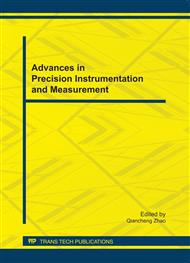[1]
Montemerlo M, Thrun S and Koller D, FastSLAM: A factored solution to the simultaneous localization and mapping problem, Proceedings of the Eighteenth National Conference on Artificial Intelligence, AAAI Press, Jul. 2002, pp.593-598.
Google Scholar
[2]
Fleck Sven, Busch Florian, Biber Peter and Straer Wolfgang, Omnidirectional 3D modeling on a mobile robot using graph cuts, Proceedings of IEEE International Conference on Robotics and Automation, IEEE Press, Apr. 2005, pp.1748-1754.
DOI: 10.1109/robot.2005.1570366
Google Scholar
[3]
Y. Boykov and V. Kolmogorov, An experimental comparison of mincut/max-flow algorithms for energy minimization in vision, IEEE Transactions on Pattern Analysis and Machine Intelligence, IEEE CS Press, Sep. 2004, p.1124.
DOI: 10.1109/tpami.2004.60
Google Scholar
[4]
A. J. Davison, D. W. Murray. Mobile robot localisation using active vision. Proceedings of the 5th European Conference on Computer Vision, Freiburg, 1998, 809-825P.
DOI: 10.1007/bfb0054781
Google Scholar
[5]
David G. Lowe, Distinctive Image Features from Scale-Invariant Keypoints, International Journal of Computer Vision, vol. 60, Nov. 2004, p.91–110, doi: 10. 1023/B: VISI. 0000029664. 99615. 94.
DOI: 10.1023/b:visi.0000029664.99615.94
Google Scholar
[6]
Lindeberg T, Scale-Space Theory in Computer Vision, Dordrecht, Netherlands: Kluwer Academic Publishers, (1994).
Google Scholar
[7]
Brown M and Lowe D, Invariant Features from Interest Point Groups, Proc. of the 13th British Machine Vision Conference (BMVC02), Cardiff, Wales, Sep. 2002, pp.656-665.
DOI: 10.5244/c.16.23
Google Scholar
[8]
Arnaud Doucet, Nando de Freitas, Kevin Murphy and Stuart Russell, Rao-blackwellised Particle Filtering for dynamic Bayesian networks, Proceedings of the Proceedings of the Sixteenth Conference Annual Conference on Uncertainty in Artificial Intelligence (UAI-00), 2000, pp.176-183.
Google Scholar
[9]
Murphy K P, Bayesian map learning in dynamic environments, Advances in Neural Information Processing System, MIT Press, vol. 12, 2000, pp.1015-1021.
Google Scholar
[10]
F. Linåker and M. Ishikawa, Real-Time Appearance-Based Monte Carlo Localization, Robotics and Autonomous Systems, vol. 54, Mar. 2006, p.205–220, doi: 10. 1016/j. robot. 2005. 11. 003.
DOI: 10.1016/j.robot.2005.11.003
Google Scholar


